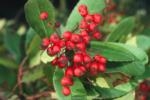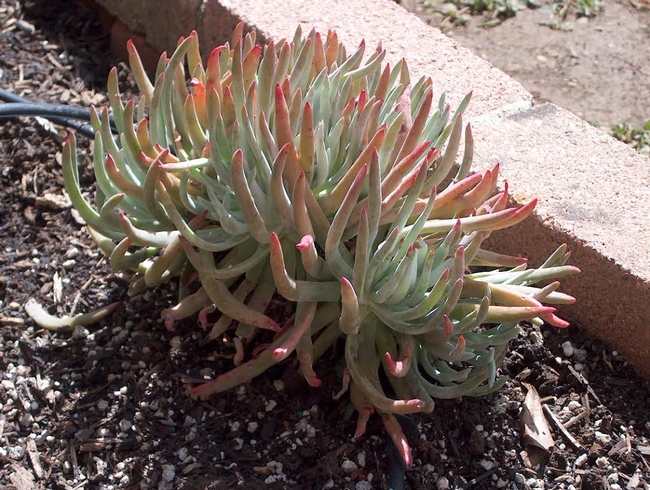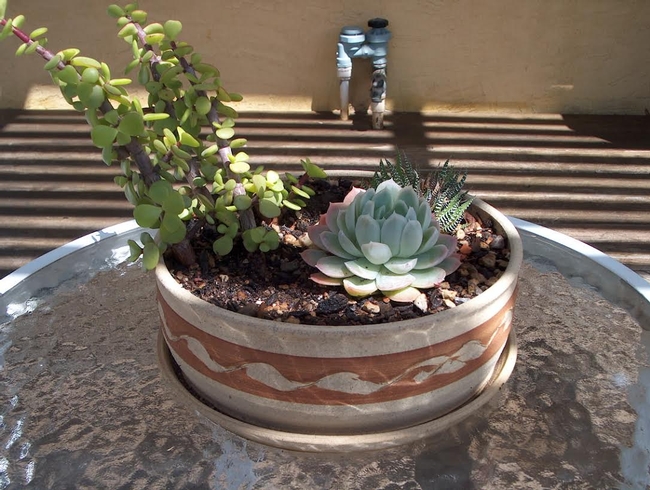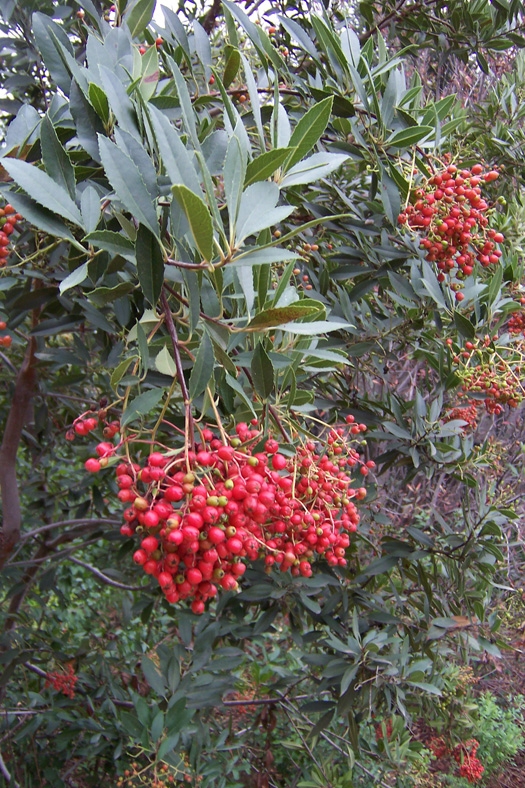Who in California needs holly? We Californians are fortunate to have a beautiful native shrub that resembles holly but outshines it. Like holly, toyon (Heteromelesarbutifolia) is evergreen and has bright red berries in winter, but it is easygoing, hearty and well adapted to our lower elevations
Toyon occurs extensively in the chaparral and woodlands surrounding the Central Valley and in other foothill regions of the state below 4,000 feet. In fact, its resemblance to European holly and its abundance in Southern California explain the origins of the name Hollywood.
Toyon got its name from the Ohlone tribe. It is also called Christmas berry or California holly. A member of the rose family, toyon typically grows 8 to 15 feet in height and width. However, some specimens grow larger and work in the landscape as small trees.
The plant has dark green, leathery, oblong leaves that are two to four inches long. In spring, the shrub is covered in flat-topped clusters of fragrant white flowers that attract bees and butterflies. As the season progresses, the flowers give way to dense clusters of small, orange-red berries that last late into the year.
These berries attract many local birds: American robins, quail, towhees, cedar waxwings, mockingbirds and various finches and sparrows. So in addition to its beauty, toyon is an excellent habitat plant. The berries also make the plant useful for home décor at Christmas, if you can get to the berries before the birds do.
Like many of its cousins in the rose family, toyon is susceptible to fireblight. The cultivar ‘Davis Gold,' developed at the University of California at Davis, has striking yellow berries and improved disease resistance. Toyon tends to be ignored by deer, although desperate deer may eat the new leaves of smaller plants.
This hearty California native tolerates serpentine, adobe and sandy soils. Unlike some other members of the rose family, toyon requires little pruning to make a great screen or help with erosion control.
For best results, don't try to contain it in a pot. Plant it in full soon and give it room to grow. Although it can take some light shade, it will be fuller and more compact in direct sun. Water deeply and infrequently the first few years to encourage deep tap roots, then sit back and enjoy all its berry beauty-ness. If you like to bird watch, be sure to plant it where you can watch the birds gorge on the winter berries.
So if Hollywood was named after the Christmas berry, could it be that the “vine” of the famous intersection Hollywood & Vine was named after another California native,Vitiscalifornica(California grape)?Heteromeles&Vitis.Toyon& Grape. Neither pair rolls off the tongue quite as nicely as Hollywood & Vine.
Workshop: U. C. Master Gardeners of Napa County will host a workshop on “Rose Pruning and Maintenance” on Saturday, January 9, from 10 a.m. to noon, at the University of California Cooperative Extension office, 1710 Soscol Avenue, Napa. This workshop will feature demonstrations of proper pruning techniques. Master Gardeners will discuss types of roses, common rose diseases and routine maintenance. On-line registration (credit card only); Mail-in registration (check only).
Workshop: U. C. Master Gardeners of Napa County will host a workshop on “Fruit Tree Pruning and Care” on Saturday, January 16, from 9:30 a.m. to 2 p.m. The workshop includes a lecture session from 9:30 a.m. to 11:30 a.m. at the University of California Cooperative Extension office, 1710 Soscol Avenue, Napa. With hands-on session at a local orchard, rain or shine,from 12:30 p.m. to 2 p.m. Please dress for outside weather conditions.On-line registration (credit card only); Mail-in/Walk-in registration (cash or check only).
Master Gardeners are volunteers who help the University of California reach the gardening public with home gardening information. U. C. Master Gardeners of Napa County ( http://ucanr.org/ucmgnapa/) are available to answer gardening questions in person or by phone, Monday, Wednesday and Friday, 9 a.m. to Noon, at the U. C. Cooperative Extension office, 1710 Soscol Avenue, Suite 4, Napa, 707-253-4143, or from outside City of Napa toll-free at 877-279-3065. Or e-mail your garden questions by following the guidelines on our web site. Click on Napa, then on Have Garden Questions? Find us on Facebook under UC Master Gardeners of Napa County.


The espalier technique was developed centuries ago in France. Gardeners there used rope to shape fruit trees and found that the trees produced a good crop. It seems that limbs trained horizontally produce more fruit than branches pointed up. However,the method does take more work and planning than an orchard layout.
Dwarf figs, apples, pears and citrus are the most common fruit trees grown as espalier. Other fruit trees are more difficult to train in this way.
You can espalier a tree against a wall unless you are in a very warm climate. In that case, the heat reflected by the wall might cause fruit and leaves to burn.
You will need to set up a trellis system on which the trees can grow. Be sure to leave enough space to move behind the trees so you can prune them easily. Then you need to install posts tall enough to support the mature trees. Seven to eight feet is suggested. Place the first wire about three feet above the ground and then one foot apart after that.
At the nursery, select trees with lots of branching. You are going to cut off most of the branches and direct the remainder along the trellis wire. If you can't find such a tree, start with a whip (a young, slender, non-branching trunk).Another alternative is to prune off all the trunk's branches and direct the new, flexible growth along the wires.
The espalier method is not something you do once to each tree and then you're done. Itis a process. It involves constant training and pruning to get branches growing in the right direction.
I suggest purchasing bare-root fruit trees because they are much less expensive than container trees.When you plant them for espalier, you use the same methods that apply to any bare-root tree. Site the trees close to the trelliswith at least six feet between each tree.
Dig a hole wide and deep enough to accommodate all the roots. You can prune some of the root tips off before planting.Create a mound inside the planting hole. Set the tree on the mound and spread the roots evenly around, then take a look. Make sure that when you back fill the planting hole, the tree is no deeper than it was before. Be sure the graft union (where the scion is grafted to the rootstock) is above the soil line.
Remove the tree and water the hole well. Then place the tree on the mound again and refill the hole with soil. Water again. You want the soil to go into all the nooks and crannies. Stomp on the soil to compact it.
Trim all branches that you cannot easily train to the wire. Tie branches to the wire with a plastic tie. Trim back the growing tip to buds coming out the sides at the next highest wire.
You will need to continue this training throughout the life of your fruit trees.
Master Gardeners are volunteers who help the University of California reach the gardening public with home gardening information. U. C. Master Gardeners of Napa County ( http://ucanr.org/ucmgnapa/) are available to answer gardening questions in person or by phone, Monday, Wednesday and Friday, 9 a.m. to Noon, at the U. C. Cooperative Extension office, 1710 Soscol Avenue, Suite 4, Napa, 707-253-4143, or from outside City of Napa toll-free at 877-279-3065. Or e-mail your garden questions by following the guidelines on our web site. Click on Napa, then on Have Garden Questions? Find us on Facebook under UC Master Gardeners of Napa County.

‘Wonderful' is the pomegranate most of us pick up at the grocery store. Originally found in a bundle of cuttings from Florida, ‘Wonderful' has been propagated widely in California since the early 1900s. But the story of pomegranates (Punicagranatum) goes back much further.
Also called Chinese apples, pomegranates are one of the oldest documented edible fruits. They require long, hot summers and can survive under myriad conditions. For best fruit production in Napa Valley, plant pomegranates in a sunny location in ordinary soil with good drainage. For the first two years, water deeply every two to four weeks in dry weather to encourage root establishment and fruit production.
When pomegranate plants are about two feet high, select four or five of the healthiest-looking branches, preferably well-spaced, and cut them back to 12 inches.Remove the remaining growth and any shoots or suckers that appear above or below these chosen branches.
Pomegranate trees can be grown as dwarfs, but most reach 15 to 20 feet tall. Disciplined pruning can keep them tidy in smaller spaces.
The pomegranate produces fruit at the end of new growth. Judicious pruning annually for the first three years will produce bushy plants with abundant new growth each year.
With their shiny, dark leaves, bright orange flowers and dramatic red fruits, pomegranates make attractive, long-lived additions to the garden. Their ruby arils—the pulp-covered seeds—are beautiful in salads and make a refreshing juice. The fruit is also used commercially for making grenadine, the sweet red syrup in a Shirley Temple. Local birds appreciate any fruit left on the tree.
No wonder the Spanish missionaries considered pomegranates essential to propagate along El Camino Real in the 1700s. Pomegranates are still often found on old homesteads and in historic gardens across the state.
By 1927 California boasted 2,750 acres of pomegranates. As of 2011, the last year the USDA tracked commercial production, California had more than 30,000 acres of pomegranate orchards.
Some fruit trees, like plums, are susceptible to oak-root rot and can't be grown near diseased oak trees. Fortunately, pomegranates do not have this issue. Sometimes the pomegranate rind splits, exposing the seeds to insects, moisture and mold. Regular watering minimizes splitting, as it does for tomatoes and other fruits. Cease watering two to three weeks before your anticipated harvest.
Allow pomegranates to ripen fully on the tree as they won't ripen further after harvest. Clip the stem to avoid damaging the fruit; do not pull the fruit off the stem.
Pomegranates actually improve in storage, becoming juicier and more flavorful. Keep the fruit cool but not cold. A temperature below 41°Fwill turnred arils pale and promote decay. Stored at the proper temperature and around 85% humidity,the fruit can last for up to seven months. When the arilsstart to fade and look streaky, flavor fades, too, and it is time to put the fruit in the compost.
Pomegranate seeds germinate readily, but you may not get a high-quality tree from seed. Most pomegranates are propagated from rooted cuttings.
A few years ago, University of California Extension fruit-tree specialists Paul Vossen and Deborah Silver published a paper recommending pomegranate varieties for our area (http://home orchard.ucdavis.edu/plant_pomegranate.pdf). They describe ‘Wonderful' as producing large, deep-red fruits with juicy red arils, small seeds and good flavor. Vossen and Silver also suggest ‘Grenada' and ‘Eversweet' for a harvest that begins in August instead of September.
And if you have space for only one? Taste different varieties to find your favorite. The good news is that even ordinary pomegranates from your grocer's shelf can be Wonderful.
Workshop: U. C. Master Gardeners of Napa County will host a workshop on “Making Wreaths from Your Garden” on Sunday, December 6, from 2 p.m. to 4 p.m., at Yountville Community Center, 6516 Washington Street, Yountville. Learn what plants from your garden will make good wreaths and how to choose and prepare plant materials to make them last a long time. Get tips and tricks for designing and making easy creative wreaths for the holidays or any time. Each participant will create a wreath to take home, using locally collected plant materials and supplies provided. To register, call the Parks and Recreation Department at 707-944-8712 or visit its web site.
Master Gardeners are volunteers who help the University of California reach the gardening public with home gardening information. U. C. Master Gardeners of Napa County ( http://ucanr.org/ucmgnapa/) are available to answer gardening questions in person or by phone, Monday, Wednesday and Friday, 9 a.m. to Noon, at the U. C. Cooperative Extension office, 1710 Soscol Avenue, Suite 4, Napa, 707-253-4143, or from outside City of Napa toll-free at 877-279-3065. Or e-mail your garden questions by following the guidelines on our web site. Click on Napa, then on Have Garden Questions? Find us on Facebook under UC Master Gardeners of Napa County.

What is the difference between cacti and succulents? All cacti are succulents but not all succulents are cacti. Named for the Latin succulentus, meaning juice or sap, succulents are defined by their liquid storage ability and belong to many different botanical families.
The cactus plant is defined by small, spherical, pillow-like structures called areoles from which spines, branches, leaves, hairs and even flowers emerge. Many succulents look similar to cactus, but if they do not have these cushiony areoles, then they are not in the cactus family (Cactaceae).
Succulents are native to most parts of the world whereas cacti occur naturally only from Alaska to Chile. In Maine, Vermont and New Hampshire, a native cactus has never been found. Surprisingly, Canada boasts several native cacti that have evolved to survive the harsh winters.
In Napa Valley's Mediterranean climate, succulents are a good choice for an easily maintained, slower-paced garden. Most require little water. However, low care does not mean no care.
Check your succulents regularly to catch and treat stressed plants quickly. An actively growing succulent may need water anywhere from once a week to once a month depending on the type and size of the plant, its location, the container and the weather.
The larger the plant and the plumper and fatter the leaves, the less water the plant needs. Keep the soil as moist as a wrung-out sponge. Use a drip system or water by hand, but moisten the soil and not the plant. Water can cause “sunburn” spots on the leaves.
If you forget to water, succulents usually adjust; if you over water, no worries. Unless waterlogged, they do fine. When in doubt, don't water.
Although they do not do well in full shade, succulents need only three to four hours of sunlight daily. Protect them from the onslaught of the midday sun. Early-morning and late-afternoon sun is best, with filtered exposure at noon. The plants need much less sun in winter, but be sure to protect them from frost. The succulent's plump leaves freeze easily.
With their shallow root systems, succulents do well in pots or in the ground. Nurseries sell container mixes for cactus, but you can make your own with two parts potting soil to one part perlite and one part coarse sand. Remove the plant from its nursery pot and spread the roots out on top of a small mound of soil. Add more soil but keep the roots shallow; press down softly to anchor the plant.
At the time of planting, add one teaspoon of slow-release fertilizer per gallon of soil. In spring, feed plants with a low-nitrogen liquid fertilizer diluted to half strength; be sure to moisten the soil first. Do not over-fertilize or the plant may develop softened foliage that is susceptible to rot.
Like all plants, succulents need occasional dividing, deadheading and pruning. They experience a growth spurt when moved to a larger pot. Some succulents are winter growers and look unwell in summer. Resist the impulse to overwater them during this period.
For most succulents, early summer is a good time to propagate. Allow new cuttings to dry or “callus” before planting them. Putting them in soil immediately encourages the cuttings to draw too much moisture and possibly rot.
Succulents are not plagued by many pests. Aphids, spider mites and mealy bugs are the most common. A judicious squirt of water from a spray bottle or hose removes these invaders easily. A cotton swab soaked in isopropyl alcohol and dabbed directly on the pest will also work. Avoid getting alcohol on the plant as it might damage the leaves. For more information on dealing with the pests that plague succulents, visitwww.ipm.ucdavis.edu.
Recently I attended a local flower show, and all the amazing ideas for using succulents really got my creative juices flowing. One display was of miniature fairy gardens complete with rock paths and little houses. My mind immediately started creating a tiny landscape of chubby, scalloped, speckled, spikey, fleshy, prickled succulents. The possibilities are endless and only limited by my imagination.
Workshops: U. C. Master Gardeners of Napa County will conduct a workshop on “Succulent Gifts” on Sunday, November 8, from 2 p.m. to 4 p.m., at the Yountville Community Center, 6516 Washington Street, Yountville. Bring your own love of succulents to this workshop dedicated to making gifts for the holidays or for yourself. Master Gardeners will concentrate on the right kind of soil and care for succulents, discuss the myriad succulent types, and help you make a succulent garden or two to give as gifts. Please bring succulent cuttings if you would like to share. Call 707-944-8712 to register or visit the Parks and Recreation web site.
“Succulent Gifts” workshop will be repeated on Saturday, November 14, from 9:30 a.m. to 11:30 a.m. at the University of California Cooperative Extension Office, 1710 Soscol Avenue, Napa.
Online registration (credit card only)Mail-in registration (cash or check only)
Master Gardeners are volunteers who help the University of California reach the gardening public with home gardening information. U. C. Master Gardeners of Napa County ( http://ucanr.org/ucmgnapa/) are available to answer gardening questions in person or by phone, Monday, Wednesday and Friday, 9 a.m. to Noon, at the U. C. Cooperative Extension office, 1710 Soscol Avenue, Suite 4, Napa, 707-253-4143, or from outside City of Napa toll-free at 877-279-3065. Or e-mail your garden questions by following the guidelines on our web site. Click on Napa, then on Have Garden Questions? Find us on Facebook under UC Master Gardeners of Napa County.


Also called lily of the Nile, agapanthus is not a lily at all. Nor is it from the Nile. It is actually from the southern part of Africa, not the northeastern part where the Nile River flows.
Still, agapanthus does have some qualities in common with lilies. If you have clumps of either agapanthus or daylilies that are getting too crowded for their space, it is time to divide them.
Were your agapanthus blooms as robust and plentiful this year as in years past? If blossoms have dwindled to just a few flowers, do a little detective work. Both agapanthus and daylilies can become root-bound, even planted in the ground.
Take a close look at the roots at soil level. If the crown of the plant is beginning to show above the soil or roots are apparent above ground, it is probably time to split the clump. Thick roots can begin to intertwine and choke themselves if you don't intervene. Typically, agapanthus and daylily clumps need to be divided every four to six years.
It is hard work to dig up a well-established clump of tuberous roots, but it gives you the opportunity to spread more flowers around your garden. Alternatively, you can give starts of blue or white agapanthus to gardeners lacking these upright, stately plants.
If the root clumps are really big or overgrown, enlist help. Some gardeners prefer to use garden forks to separate the tangled roots into three or four sections. Other gardeners cut straight through roots with a sharp, straight shovel, like slicing a pie into quarters.
Agapanthus roots are tough. Brush or rinse off the dirt and remove any dead, soft or weak-looking roots. Make sure each division has at least one or two growing points. Weed and prepare their new or revived bed and replant.
Agapanthus likes good drainage, but it does not need a super-cushy bed. Too much nitrogen can produce tender foliage that is more easily damaged by frost. Space new plants 12 to 18 inches apart.That's enough room to grow, yet close enough to help each other stay upright. Tall varieties that can reach 4 to 5 feet in height need more space than short varieties like ‘Peter Pan,' the agapanthus that “never grows up.” These dwarf varieties top out at about 18 inches and are useful in the front of mixed beds or along borders.
Agapanthus is a star in garden beds, attracting honey bees, ground bees and a variety of other pollinators. Agapanthus does well in large containers, too, so pots on the deck or patio can be a good solution if you have garden areas that are too waterlogged in winter to host them. Most agapanthus come in hues of blue and blueish-purple, but white agapanthus are common, and pink blossoms are available, albeit more rare.
In my experience, agapanthus is very forgiving. An agapanthus in a five-gallon pot sat on my deck for four years, finally getting so obviously crowded that I had to free it. That one pot provided a 15-foot-long border of liberated agapanthus. All were blooming within a few months, rewarding my deferred maintenance.
Whether in roadside plantings or in cottage gardens, agapanthus is an easy-care favorite. Preferring sunny, well-drained soil with south- or west-facing exposure, the plants flower from midsummer to early autumn.
After flowering, cut the stalks but leave the strappy foliage to collect energy from the sun and prepare for next year's bloom. If uncut, the flowers will develop blackish-brown seeds that open and drop on the ground.
You can grow agapanthus from seed, but you have to be patient. It may take two or three years before blossoms appear. Still, agapanthus seeds germinate reliably, so if you enjoy growing plants from seed and have room in your garden for baby agapanthus, starting from seed is an economical way to grow them. Instructions for collecting and propagating seeds can be found on The Royal Horticultural Society's website, along with information on different cultivars to consider for your garden.
Workshop: U. C. Master Gardeners of Napa County will conduct a workshop on “Succulent Gifts” on Sunday, November 8, from 2 p.m. to 4 p.m., at the Yountville Community Center, 6516 Washington Street, Yountville. Bring your own love of succulents to this workshop dedicated to making gifts for the holidays or for yourself. Master Gardeners will concentrate on the right kind of soil and care for succulents, discuss the myriad succulent types, and help you make a succulent garden or two to give as gifts. Please bring succulent cuttings if you would like to share. Call 707-944-8712 to register or visit the Parks and Recreationweb site.
Master Gardeners are volunteers who help the University of California reach the gardening public with home gardening information. U. C. Master Gardeners of Napa County ( http://ucanr.org/ucmgnapa/) are available to answer gardening questions in person or by phone, Monday, Wednesday and Friday, 9 a.m. to Noon, at the U. C. Cooperative Extension office, 1710 Soscol Avenue, Suite 4, Napa, 707-253-4143, or from outside City of Napa toll-free at 877-279-3065. Or e-mail your garden questions by following the guidelines on our web site. Click on Napa, then on Have Garden Questions? Find us on Facebook under UC Master Gardeners of Napa County.


